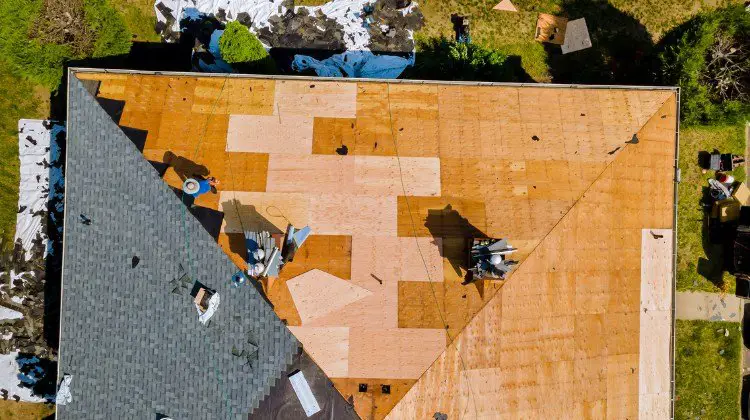As a homeowner, few things are more unsettling than a damaged roof. It’s the primary shield protecting everything you hold dear from the elements. Now, imagine facing a hefty roof replacement cost and wondering, “Will my insurance foot the bill for roof replacement?”. It’s a common concern, and I’m here to walk you through the ins and outs of when insurance might cover your new roof .
For the past eleven years, I’ve specialized in helping homeowners understand the often-complex world of insurance, specifically when it comes to roof replacements. Through countless conversations and firsthand experiences, I’ve seen both the relief of claims approved and the disappointment of unexpected out-of-pocket costs.
Table Of Contents:
- When Does Insurance Typically Cover Roof Replacement?
- Understanding Your Policy and “Insurance Foot the Bill for Roof” Coverage
- The Age and Condition of Your Roof Matter
- Conclusion
When Does Insurance Typically Cover Roof Replacement?
Let’s face it, insurance policies can be about as clear as mud sometimes. But, knowing how insurance companies view roof damage claims can help manage expectations. In most cases, your homeowner’s insurance is designed to step in when your roof is damaged by a sudden, unexpected event. This is what insurance companies like to call “covered perils.”
Think along the lines of:
- Storm Damage : This one’s a no-brainer—if a hurricane rips through your town or a hailstorm leaves your roof looking like a golf ball, your insurance is likely to cover the damage. You may need to provide evidence of the storm, such as a weather report, to support your claim.
- Fire Damage : House fires are, thankfully, less common. But, if a fire damages your roof, your insurance will likely help with the replacement. It’s important to note that your insurance company will want to determine the cause of the fire to make sure it wasn’t caused by something that’s excluded from your policy, like arson.
- Falling Objects : A tree limb crashing onto your roof is a homeowner’s nightmare. Good news is, this type of damage typically falls under covered perils. However, your insurance company may deny your claim if they determine that the tree was dead or diseased and you should have removed it before it fell.
- Vandalism : If mischief-makers damage your roof, your homeowner’s policy should have you covered. You’ll want to file a police report in these instances, too. This will provide documentation of the vandalism and support your claim.
These scenarios highlight situations where damage is outside your control. This is when insurance is most likely to cover your roof, although every policy has limitations, and each claim is evaluated based on its specific circumstances. For a deeper understanding of your policy’s dwelling coverage for roof damage, a homeowners insurance policy review can provide clarity.
Understanding Your Policy and “Insurance Foot the Bill for Roof” Coverage
I get it. You’re busy. Reading through lines of insurance jargon is probably the last thing you want to do. But, trust me, understanding the specific terms and conditions of your homeowners insurance policy can save you a whole lot of headaches (and potentially money) down the line.
Coverage Limits
One of the first things to wrap your head around is your policy’s coverage limits. This essentially means there’s a maximum amount your insurance company will pay out for a claim. It might be a specific dollar amount or a percentage of your home’s total value. Understanding this helps you assess whether your coverage is adequate or needs adjustments. You don’t want to find out you’re underinsured when you have a major claim.
Deductibles
Deductibles—that magic number you have to pay out of pocket before your insurance coverage kicks in. Your policy will specify a deductible for different types of claims, including those related to roof damage. Deductibles can be tricky, as choosing a higher deductible can mean lower monthly premiums, but a higher out-of-pocket cost if you need to file a claim. On the other hand, a lower deductible will mean higher premiums, but you’ll pay less out of pocket if you need to file a claim.
Actual Cash Value vs. Replacement Cost Value
This is a BIG one, folks. It trips up a lot of homeowners. Insurance policies often offer coverage based on either Actual Cash Value (ACV) or Replacement Cost Value (RCV). Here’s a breakdown:
| Coverage Type | How It Works | Example |
|---|---|---|
| Actual Cash Value (ACV) | Factors in depreciation. Pays you the current market value of your roof, considering its age and condition. | You need a new roof after a hailstorm. The roof is 15 years old, and your policy offers ACV coverage. The insurance might only cover a fraction of the replacement cost after accounting for 15 years of wear and tear. |
| Replacement Cost Value (RCV) | Does not factor in depreciation. Pays you the cost to replace your roof with materials of similar quality at today’s prices. | If your 15-year-old roof had an RCV policy, the insurance is likely to pay out a larger sum, closer to what it’d actually cost to install a brand-new version of your existing roof. |
It’s important to understand what type of coverage you have so you know what to expect if you need to file a claim. If you’re not sure what type of coverage you have, you can contact your insurance agent or company to find out.
Exclusions
No insurance policy covers every possible scenario, and this is where exclusions come in. Exclusions are specific situations or causes of damage that are NOT covered by your policy. For example, if you haven’t maintained your roof properly, resulting in preventable damage or leaks , your claim could be denied. This reinforces how crucial routine roof maintenance is.
Other common exclusions include:
- Damage from pests or rodents
- Damage from wear and tear
- Damage from nuclear hazards
- Damage from acts of war
It’s important to read your policy carefully so you understand what is and is not covered. If you have any questions, be sure to contact your insurance agent or company for clarification.
The Age and Condition of Your Roof Matter
This is often a sticking point when “insurance foot the bill for roof” situations come up. Picture this—your roof has endured years of scorching sun, driving rain, maybe even a few rogue squirrels. Now, it’s starting to show its age. When you file a claim, your insurance company will send out an insurance adjuster to assess the damage and determine the cause.
Here’s what they’ll consider:
- Roof Age : A relatively new roof, say 5–10 years old, in good condition, is more likely to receive full or near-full coverage after a covered peril. An older roof (20+ years), may lead to a partial payout or even a denied claim if poor maintenance contributed to the damage. Insurance companies use a process called recoverable depreciation to determine how much your roof has depreciated over time.
- Roof Condition : Even a relatively new roof can be susceptible to damage or deterioration if not maintained correctly. Cracked or missing shingles, clogged gutters, and signs of previous repairs can all affect a claim. Insurance companies want to know if you took care of what you already have. It’s important to have regular roof inspections and to make any necessary roof repairs in a timely manner.
If you’re not sure about the age or condition of your roof, you can hire a reputable roofing contractor to perform a roof inspection. They can give you an idea of the overall health of your roof and let you know if there are any areas of concern.
Navigating the Claims Process
No one enjoys dealing with insurance claims. But, when you’re staring down a roof replacement, knowing the process can make it a bit smoother. Remember, when filing a roof damage claim: documentation is your best friend. It substantiates your claim, so don’t skimp on it.
Here are a few essential steps :
- Contact your insurance company immediately. The sooner, the better, especially when damage is weather-related. Don’t delay, as some insurance policies have time limits for reporting. You can usually file a claim online, over the phone, or through your insurance company’s mobile app.
- Document the damage extensively: Take detailed photos and videos of ALL damaged areas before you begin any temporary repairs to prevent further damage (and be sure to save receipts for these temporary repairs). These visuals will be invaluable when making your case.
- Work with a reputable roofing contractor: Getting multiple estimates for the repairs helps you understand the actual cost. It also shows your insurance company you’ve done your homework. When choosing a roofing contractor, be sure to get recommendations from friends, family, or neighbors. You can also check online reviews.
- Be thorough and responsive with the adjuster: Answer their questions completely and provide any documentation promptly. The insurance adjuster will work with you to determine the cause of the damage and the amount of coverage you’re eligible for.
- Review the claim settlement carefully: Ensure it covers the necessary repairs or replacements. You have the right to negotiate a fair settlement. If you’re not happy with the settlement offer, you can always appeal it.
Remember that your insurance company is a business and they’re looking out for their bottom line. By being prepared and organized, you’ll be in a better position to get the coverage you deserve. If you’re having trouble navigating the claims process on your own, you can always hire a public insurance adjuster to help you. Public adjusters work for you, not the insurance company, and they can help you get the maximum settlement possible.
Conclusion
Navigating the world of homeowners insurance and understanding when “insurance foot the bill for roof” replacements can feel complex, I get it. I’ve seen firsthand how this question weighs heavily on homeowners. Understanding your coverage, policy limits, deductibles, and exclusions, helps to take away some of the uncertainties, but nothing beats having an expert on your side.









Reader Interactions